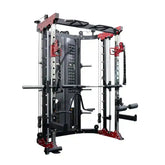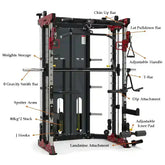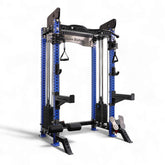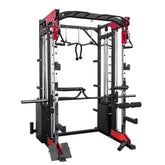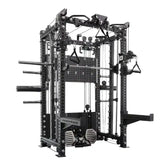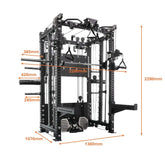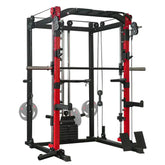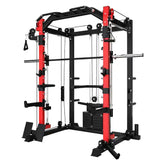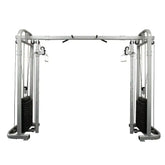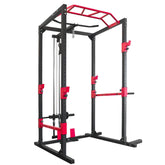Build Balanced Strength Safely with the Smith Machine
The Smith machine is one of the most effective tools for building balanced, symmetrical strength. It allows you to isolate muscles safely, refine your form, and train with confidence — ideal for athletes, lifters, and home gym users focused on long-term performance and control.
Build balanced, controlled strength with the Smith machine — refine form, grow muscle, and train safely at any level.
Why I Always Return to the Smith Machine
When I was competing, the Smith machine was one of my best-kept secrets. Many lifters see it as a “beginner’s tool,” but for me — and the athletes I coach today — it’s one of the most efficient and controlled ways to build strength safely.

After more than a decade in the gym, I’ve learned that true progress comes from precision, not just power. The Smith machine provides a guided movement path that helps you lift heavy, protect your joints, and perfect your form with confidence.
I use it to help clients develop powerful legs, rounded shoulders, stable cores, and strong chests — all with control, safety, and purpose.
Why Controlled Lifting Builds Better Muscle
In bodybuilding, I always teach that there are two types of strength:
-
Raw strength — moving heavy weight.
-
Smart strength — controlling that weight with precision.
The Smith machine is built for developing smart strength. Because the bar moves along a fixed track, your stabilisers don’t have to fight for balance — allowing you to focus purely on muscle activation and control.
That’s how you build symmetry and definition. It’s not just about lifting the weight — it’s about feeling every inch of the movement and mastering technique with purpose.
How to Build Muscle Using the Smith Machine
Let’s break down how to use the Smith machine to target key muscle groups effectively. These are the same exercises I use with bodybuilding and performance clients to develop balanced size, control, and definition.

1. Build Powerful Legs with Smith Squats
Primary Muscles Worked: Quads, Glutes, Hamstrings
If you want leg size and power — the kind that builds real lower-body strength — this is your move.
How to Do It:
-
Position your feet slightly forward under the bar.
-
Keep your chest high and core engaged.
-
Lower until your thighs are parallel to the floor.
-
Drive upward through your heels, squeezing your glutes at the top.
Coach’s Tip: I tell my athletes to “move slow to grow.” Control the descent, feel the stretch, and push evenly — no bouncing.
Why It Works: The Smith machine’s guided bar path ensures proper alignment and balance, allowing you to load safely and effectively while reducing stress on your knees and lower back.
2. Build a Defined Chest with the Smith Bench Press
Primary Muscles Worked: Pectorals, Front Delts, Triceps
A wide, dense chest comes from controlling every rep, not just pushing heavy weight. The Smith machine allows you to train with intensity and confidence — no spotter required.
How to Do It:
-
Position your bench so the bar lines up with your mid-chest.
-
Lower the bar slowly until your elbows reach 90 degrees.
-
Press upward in a straight path, focusing on squeezing your chest at the top.
Coach’s Tip: Adjust your bench incline slightly each week to target different areas of the chest — upper, middle, and lower — for balanced development.
Why It Works: The Smith bench press provides consistent stability and bar control, allowing you to increase time under tension, one of the most effective methods for stimulating muscle growth and definition.
3. Shape Your Shoulders with the Smith Overhead Press
Primary Muscles Worked: Deltoids, Triceps, Upper Chest
A round, defined shoulder creates that signature V-taper look — strong, balanced, and aesthetic. The Smith machine lets you train your shoulders safely and effectively, without putting unnecessary strain on your lower back.
How to Do It:
-
Sit upright with the bar positioned at chin height.
-
Keep your core braced and feet planted firmly.
-
Press upward in a controlled motion until just before lockout.
-
Lower slowly, maintaining tension through your shoulders.
Coach’s Tip: Don’t rush the reps. A slower tempo creates greater control — and deeper muscle engagement for lasting strength and definition.
4. Strengthen the Posterior Chain with Smith Romanian Deadlifts
Primary Muscles Worked: Hamstrings, Glutes, Lower Back
This movement builds the foundation of total-body power — strong hips, glutes, and hamstrings. The Smith machine provides a guided bar path, allowing you to train the posterior chain safely and with perfect control.
How to Do It:
-
Grip the bar at hip height with your feet shoulder-width apart.
-
Keep a soft bend in your knees and hinge at the hips, lowering the bar until you feel a deep stretch in your hamstrings.
-
Drive your hips forward to return to the starting position, standing tall at the top.
Coach’s Tip: Don’t round your back — think “hips back, chest proud.” This keeps your spine neutral, engages your glutes fully, and reinforces proper lifting posture.
5. Add Definition with Smith Lunges
Primary Muscles Worked: Quads, Glutes, Core
This is one of my go-to unilateral exercises for addressing strength imbalances and building balanced lower-body development. The Smith machine provides support and stability, allowing you to focus on depth, alignment, and muscle engagement.
How to Do It:
-
Step one foot forward and the other back into a split stance.
-
Lower your back knee toward the floor under control.
-
Drive up through your front heel, maintaining balance and tension throughout.
Coach’s Tip: Keep your torso upright and shoulders back — good posture doesn’t just look strong, it builds it.
My Healthy Living Philosophy: Fuel What You Build
I’ve coached hundreds of athletes, and one truth never changes — your training is only as effective as your recovery and nutrition.
When I was younger, I made the mistake of thinking that more training automatically meant more progress. It wasn’t until I learned to eat, rest, and recover properly that my body truly transformed.
Here’s what I’ve learned over the years:
-
Protein rebuilds the muscles you challenge in the gym.
-
Carbs refuel energy and sustain high performance.
-
Healthy fats support hormones and joint function.
-
Sleep and hydration are your recovery superpowers.
But it’s not just about macros — it’s about how you feel.
I encourage every athlete I train to view food as fuel, not restriction.
Eat whole, nutrient-dense foods, avoid extremes, and stay consistent.
Healthy living isn’t about limits — it’s about longevity, balance, and self-respect.
Coach’s Insight: “You can’t out-train poor recovery. Building strength means respecting your body — in the gym, at the table, and in life.”
Recovery and Longevity: The Silent Strength Builders
The older I get, the more I value recovery as a performance tool. When I was competing, I learned the hard way that overtraining doesn’t make you stronger — it breaks you down.
The Smith machine lets you train heavy while reducing strain on your joints and stabilisers, giving you intensity without unnecessary impact. But recovery isn’t just about rest — it’s about what you do between sessions that determines long-term progress.
Mobility and Stretching
After each workout, spend 5–10 minutes opening your hips, chest, and shoulders. Because the Smith machine follows a fixed motion, adding mobility work keeps your stabilisers balanced and your movement fluid.
Active Recovery Days
Instead of taking complete rest days, include light sessions like walking, foam rolling, or reformer Pilates work. These activities promote blood flow, reduce stiffness, and prepare your body for the next lift.
Mental Reset
Strength isn’t just physical. Sometimes the best thing you can do is step away — get outside, enjoy a good meal, and breathe. A strong mindset supports consistent performance and sustainable results.
Sample Smith Machine Program for Balanced Growth
Here’s a simple but effective 4-day Smith machine split I use with intermediate athletes to build balanced size, strength, and control:
|
Day |
Focus |
Key Exercises |
|
Monday |
Legs & Core |
Smith Squat, Lunges, Calf Raise |
|
Tuesday |
Chest & Triceps |
Bench Press, Incline Press, Push-Ups |
|
Thursday |
Back & Hamstrings |
Romanian Deadlift, Bent Row, Shrugs |
|
Saturday |
Shoulders & Arms |
Overhead Press, Upright Row, Bicep Curl |
Progression Rule: Increase your weight or reps gradually while maintaining perfect control.
Your goal isn’t to rush progress — it’s to build strength that lasts, safely and consistently.
Common Mistakes I See in the Smith Machine
Even experienced lifters make these common mistakes when using the Smith machine — and correcting them can make a huge difference in performance and safety:
-
Treating it like autopilot. You still need core engagement and control. Let your body guide the lift, not just the rails.
-
Partial range of motion. Depth equals strength. Move through a full range of motion to build complete development and mobility.
-
Neglecting balance. Incorporate free-weight days into your program to keep your stabilisers active and your movement mechanics sharp.
-
Skipping warm-ups. Your joints need mobility prep before loading heavy — spend a few minutes on dynamic warm-ups to protect your body and improve lift quality.
Remember: The Smith machine offers controlled lifting, not effortless lifting. Precision and focus are what make it powerful.
How to Integrate the Smith Machine into Your Home Gym
The Smith machine is the backbone of a complete strength setup. It combines safe, controlled movement with versatility, making it ideal for lifters of all experience levels.
Pair it with:
-
A Squat Rack — for open-bar freedom and compound lifting.
-
A Leg Press Machine — for high-volume lower-body training.
-
A Set of Dumbbells — for isolation work and accessory strength.
With these essentials, you’ll have everything you need for full-body development and progression — right at home.
Final Thoughts from the Coach
The Smith machine isn’t about shortcuts — it’s about building strength that lasts.
It allows you to train safely, refine your form, and focus on pure muscle engagement without compromise.
When combined with proper nutrition, smart recovery, and consistent movement, it becomes one of the best tools for total-body development and long-term performance.
I’ve used it to help athletes rebuild strength, sculpt balanced physiques, and extend their training longevity by years.
It’s more than a machine — it’s a foundation for sustainable progress.
Start checking your equipment here or contact us now.
Frequently Asked Questions
Can I build muscle with a Smith machine?
Yes. The fixed bar path helps you lift safely and with full control, making it an excellent tool for building balanced muscle and strength while maintaining proper form.
What muscles can I target?
You can train your legs, chest, shoulders, back, and arms using the Smith machine for exercises like squats, presses, and rows — a full-body solution for consistent progress.
Is the Smith machine good for home gyms?
Absolutely. It’s compact, versatile, and safe for solo training, making it a great centrepiece for any home gym setup.
How is it different from a squat rack?
The Smith machine guides your movement along a fixed path, providing added stability and safety, while a squat rack allows for free movement and balance development. Using both gives you a complete balance of strength, stability, and control.
How often should I train with it?
For most lifters, 2–3 sessions per week is ideal. Focus on different muscle groups each session and control every rep — quality over quantity delivers the best results.

